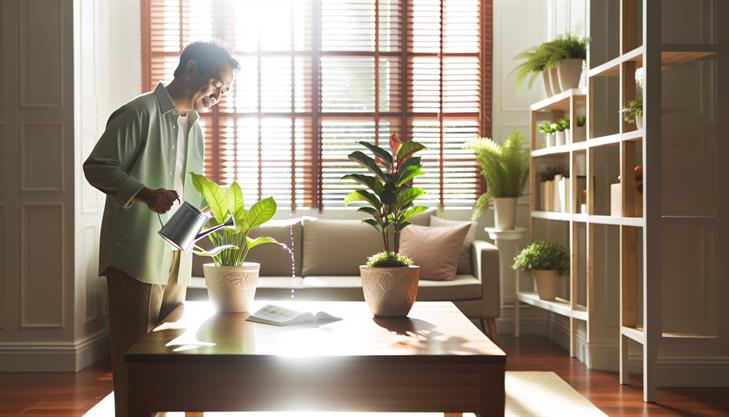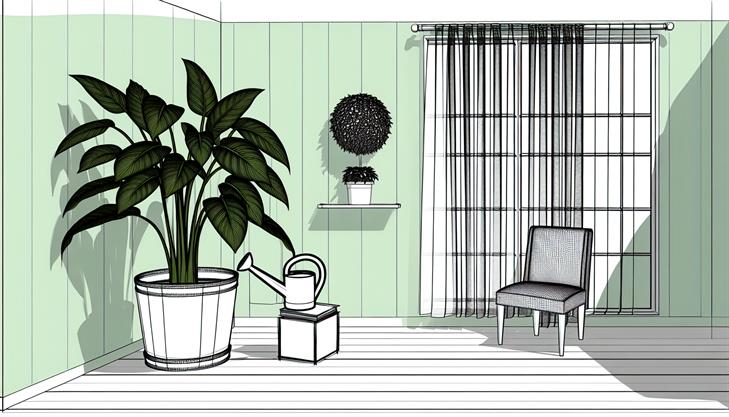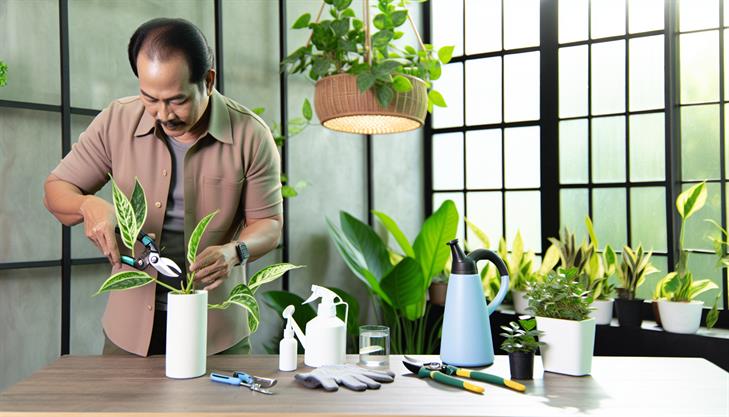If you’re looking to bring a slice of tropical charm into your home, Dieffenbachia, also known as the Dumb Cane, might just be the perfect plant for you. With its lush leaves and striking variegation, this houseplant effortlessly adds a touch of elegance and vibrancy to any space. However, its beauty comes with the responsibility of proper care, and that’s where many plant enthusiasts find themselves at a loss. Whether you’re a seasoned green thumb or a budding plant parent, understanding how to nurture and maintain your Dieffenbachia is crucial for its flourishing. Not only does proper care ensure that your plant remains healthy and vibrant, but it also contributes to the overall ambiance and air quality of your home. In this comprehensive guide, we’ll delve into everything you need to know about Dieffenbachia care—from ideal lighting conditions to watering tips and common pitfalls to avoid—ensuring your leafy companion thrives and continues to captivate. Join us as we uncover the secrets to maintaining this stunning tropical staple!
Step-by-Step Guide to Planting Dieffenbachia
Caring for a Dieffenbachia, commonly known as the Dumb Cane, involves understanding its specific needs to ensure it thrives in your home. This beautiful tropical plant is known for its broad leaves marked with spots and patches of cream, yellow, or white. Here’s a step-by-step guide to help you successfully care for your Dieffenbachia.
Choosing the Right Location
- Light Requirements: Place your Dieffenbachia in bright, indirect light. Direct sunlight can scorch its leaves, while too little light may cause the leaves to lose their vibrant color. A spot near a window with filtered light is ideal.
- Temperature and Humidity: Maintain a consistent temperature between 65°F and 75°F (18°C to 24°C). Avoid cold drafts and sudden temperature changes. Dieffenbachias prefer a humid environment, so consider using a humidifier or placing a tray of water nearby to increase humidity levels.
Soil and Potting
- Soil Type: Use a well-draining potting mix. A standard houseplant soil with added perlite or sand works well to ensure proper drainage.
- Pot Selection: Choose a pot with drainage holes to prevent water from accumulating at the bottom, which can lead to root rot.
Watering Instructions
- Watering Schedule: Water your Dieffenbachia when the top inch of soil feels dry to the touch. This is usually once a week, but it can vary based on your home’s climate and the season. Overwatering is a common mistake that may lead to yellowing leaves and root rot.
- Watering Technique: Water thoroughly until water drains out of the bottom, then empty any excess water from the saucer to prevent the roots from sitting in water.
Fertilizing Tips
- Fertilizer Type: Feed your Dieffenbachia with a balanced liquid fertilizer diluted to half strength every 4-6 weeks during the growing season (spring and summer). Reduce feeding during the fall and winter months.
Pruning and Maintenance
- Pruning Advice: Prune your Dieffenbachia to maintain its shape and encourage growth. Remove any dead or yellow leaves to promote healthy foliage. Cut back any overgrown stems to your desired height at a node.
- Common Issues: Watch for common pests like spider mites and mealybugs. Regularly inspect its leaves and treat any infestations promptly with insecticidal soap or neem oil.
Additional Care Tips
- Repotting: Repot your Dieffenbachia every 2-3 years, or when it becomes root-bound, into a slightly larger pot to accommodate growth.
- Safety Note: Handle with care. The sap of Dieffenbachia can be irritating to skin and toxic if ingested. Keep it away from pets and small children.
Following these steps will help you maintain a healthy, thriving Dieffenbachia, adding a touch of tropical beauty to your home. Pay close attention to the plant’s needs, adjusting light, watering, and feeding routines as necessary, and you’ll enjoy this delightful houseplant for years to come.
Optimal Watering and Light Conditions for Dieffenbachia
Caring for a Dieffenbachia plant can be a rewarding experience that transforms your indoor space with lush, tropical greenery. Known for their beautiful, variegated leaves, these plants are relatively low-maintenance if you understand their needs. Here’s a comprehensive guide to optimal watering and light conditions for Dieffenbachia that will ensure your plant thrives.
Watering Dieffenbachia
Dieffenbachia plants prefer evenly moist soil but are susceptible to root rot if overwatered. To achieve the right balance:
-
Check Soil Moisture: Before watering, check the top inch of soil. If it feels dry to the touch, it’s time to water. You can use your finger or a moisture meter for accuracy.
-
Water Thoroughly: When watering, do so until water drains from the bottom of the pot. This ensures that the entire root system is nourished and prevents salt build-up that can occur from fertilizer use.
-
Humidity Considerations: Dieffenbachia prefers a humid environment. During dry months, consider misting the leaves with water, using a pebble tray, or employing a humidifier to maintain adequate humidity levels.
-
Adjusting for Seasons: Dieffenbachia requires more frequent watering during the active growing season (spring and summer) and less in the dormant season (fall and winter).
Light Conditions
Proper lighting is crucial for maintaining the vibrant appearance of Dieffenbachia leaves:
-
Bright, Indirect Light: Dieffenbachia thrives in bright, indirect light. Place it near a window with filtered light, such as behind a sheer curtain. Direct sunlight can scorch its leaves, causing unsightly burn marks.
-
Avoid Low Light: While this plant can tolerate low-light conditions, insufficient light can lead to leggy growth and pale leaves. If your plant seems to be stretching or losing its vibrant color, try moving it to a brighter spot.
-
Repositioning as Needed: As the seasons change, the lighting in your home may also shift. Be mindful of these changes and adjust the plant’s position as necessary to ensure it continues to receive adequate light.
Common Issues and Additional Tips
- Yellowing Leaves: This could indicate overwatering, poor drainage, or insufficient light. Review your watering schedule and ensure the plant is positioned in adequate lighting.
- Leaf Drop: This might occur due to sudden temperature changes, drafts, or stress from moving. Keep your Dieffenbachia away from cold drafts, heaters, and air conditioning vents.
- Pruning and Maintenance: Regularly remove yellow or dead leaves to encourage new growth and maintain the plant’s health.
Additional Advice
- Soil Requirements: Use a well-draining potting mix to prevent water accumulation at the roots.
- Pot Choice: Ensure your pot has drainage holes to allow excess water to escape.
- Feeding: Fertilize monthly with a balanced liquid fertilizer during the growing season to support its growth and maintain foliage vitality.
By following these guidelines, you can easily manage how to care for a Dieffenbachia plant, ensuring its longevity and continued beauty in your home. As with all plants, observing and tending to its needs will allow you to adjust your care routine for the optimal health of your Dieffenbachia.
Essential Care Tips for Healthy Growth
Caring for Dieffenbachia, also known as Dumb Cane, involves understanding its particular needs to ensure healthy growth. This tropical plant is popular for its large, vibrant leaves and the aesthetic appeal it brings to indoor spaces. Here’s a guide on how to care for Dieffenbachia effectively:
Light Requirements
Dieffenbachia thrives in bright, indirect light. Direct sunlight can scorch its leaves, so aim for filtered light or a location where it can receive dappled sunlight. If natural light is lacking, consider using a fluorescent grow light to supplement its needs.
Watering Guidelines
Watering is crucial when caring for Dieffenbachia. The plant prefers consistently moist soil but is sensitive to overwatering, which can lead to root rot. Allow the top inch of soil to dry out between waterings. To determine the right time to water, insert your finger into the soil; water if it feels dry.
Humidity and Temperature
Being a tropical plant, Dieffenbachia prefers higher humidity levels. A room humidity of 60% or more is ideal. You can increase humidity by misting the leaves regularly, placing a humidifier nearby, or using a pebble tray with water. The plant does well in temperatures ranging from 65°F to 75°F (18°C to 24°C). Avoid placing it near cold drafts or heat sources like radiators and fireplaces.
Soil and Potting
Use a well-draining potting mix rich in organic matter. A mix designed for houseplants or containing peat, pine bark, and perlite will work well. Ensure the pot has adequate drainage holes to prevent waterlogging.
Fertilization
Feed your Dieffenbachia every 4-6 weeks during the growing season (spring and summer) with a balanced, water-soluble fertilizer. Dilute the fertilizer to half strength to avoid over-fertilization, which can harm the plant.
Pruning and Maintenance
Pruning helps maintain the shape and remove damaged or yellowing leaves. Use clean, sharp scissors or pruning shears to cut foliage at the base. This not only encourages new growth but also prevents potential pest and disease issues.
Common Issues
- Leaf Browning or Drooping: Often caused by overwatering or insufficient humidity. Adjust your watering habits and enhance humidity.
- Yellow Leaves: This can indicate underwatering or nutrient deficiencies. Ensure consistent watering and consider a balanced fertilizer.
- Pests: Look out for common pests like spider mites and aphids. Treat infestations with insecticidal soap or neem oil spray.
Additional Advice
- Repotting: Repot every 2-3 years in spring to refresh the soil and provide room for growth.
- Safety Note: Dieffenbachia sap can be irritating to skin and toxic if ingested. Keep the plant out of reach of children and pets, and wear gloves when handling.
By following these essential care tips, your Dieffenbachia will remain healthy and vibrant, enhancing your living space with its striking foliage.
Tools and Techniques for Pruning and Maintenance
Caring for a Dieffenbachia, also known as the dumb cane, can be a rewarding experience with the right knowledge and tools. This tropical plant is known for its striking variegated leaves and is popular in many households due to its easy maintenance. Below, we explore practical steps and essential tips for successfully maintaining your Dieffenbachia.
1. Choosing the Right Location:
Dieffenbachias thrive in indirect but bright light. Position your plant near a north or east-facing window where it can receive filtered sunlight. Avoid direct sunlight to prevent leaf scorching, while too little light can lead to leggy growth and less vibrant foliage. If natural light is inadequate, consider using artificial grow lights to supplement.
2. Watering Practices:
When considering how to care for Dieffenbachia, proper watering is crucial. Water the plant when the top inch of soil feels dry to the touch. Overwatering can lead to root rot, while underwatering may cause the leaves to droop. Always ensure your pot has drainage holes to prevent standing water at the roots.
3. Humidity and Temperature:
Dieffenbachias prefer high humidity levels. To boost humidity, regularly mist the leaves, use a pebble tray with water under the pot, or place a humidifier nearby. Maintain a consistent temperature between 60-75°F (15-24°C). Avoid cold drafts or sudden temperature fluctuations as these can stress the plant.
4. Soil and Fertilization:
Use well-draining, peat-based potting soil to support healthy growth. Fertilize your Dieffenbachia monthly during the growing season (spring and summer) with a balanced, water-soluble fertilizer. Reduce feeding during fall and winter when the plant’s growth naturally slows.
5. Pruning and Maintenance:
Pruning is an essential part of maintaining your Dieffenbachia. Remove any yellowing or damaged leaves with sterilized scissors to encourage healthy growth. If your plant becomes too tall or leggy, cut back the stems just above a leaf node. This stimulates new, bushier growth.
6. Common Issues and Solutions:
Keep an eye out for common problems such as pests like spider mites and aphids. Wipe the leaves with a damp cloth or apply insecticidal soap to manage infestations. If you notice browning leaf tips, check the humidity levels and ensure consistent watering practices.
7. Repotting Guidance:
Repot your Dieffenbachia every 2-3 years in a slightly larger pot to accommodate root growth. Spring is an ideal time for repotting since it coincides with the active growing season. Gently remove the plant from its current pot, loosen the roots, and place it in fresh soil in the new container.
By following these guidelines, your Dieffenbachia can thrive, adding lush greenery to your indoor space. Regular observation and the right interventions will ensure your plant remains healthy and vibrant for years to come.
Troubleshooting Common Dieffenbachia Problems
Dieffenbachia, commonly known as the dumb cane, is a popular houseplant admired for its attractive, variegated leaves and low-maintenance requirements. When cared for properly, dieffenbachia can thrive indoors and adds a lush, tropical feel to any space. However, like any plant, it can encounter some challenges. Here’s a thorough guide on how to care for your dieffenbachia and troubleshoot common problems:
Light Requirements
Dieffenbachia prefers bright, indirect sunlight. Too much direct sunlight can scorch the leaves, while too little light can cause the plant to become leggy. To find the perfect spot, place your dieffenbachia near a window with filtered light. A north or east-facing window is usually ideal.
Watering Instructions
The key to watering dieffenbachia is balance. Overwatering can lead to root rot, while underwatering can cause the leaves to wilt. Allow the top inch of soil to dry out between waterings. During the growing season (spring and summer), you may need to water more frequently. In the fall and winter, reduce watering as the plant’s growth slows.
Humidity and Temperature
Dieffenbachia enjoys a humid environment. Aim for a humidity level of 60-70%. If your home is dry, especially during winter, consider using a humidity tray or a humidifier. These plants prefer temperatures between 65-75°F (18-24°C). Keep them away from cold drafts and sudden temperature changes which can cause stress.
Soil and Fertilization
Use a well-draining potting mix with good aeration, such as a blend of peat, perlite, and potting soil. Dieffenbachia benefits from monthly fertilization during the growing season. Use a balanced, water-soluble houseplant fertilizer diluted to half strength. Avoid fertilizing in fall and winter.
Pruning and Repotting
Regularly remove any yellowing or dead leaves to maintain plant health. If the plant becomes too leggy, you can prune back the stems to encourage bushier growth. Repotting is typically necessary every two to three years or when the plant becomes root-bound. Choose a pot slightly larger than the current one to give the roots space to grow.
Troubleshooting Common Problems
-
Yellow Leaves: This is often due to overwatering. Check the soil moisture and allow it to dry out more between waterings. It could also be a sign of low humidity, so consider increasing the ambient moisture.
-
Brown Leaf Tips: Usually an indication of low humidity or inconsistent watering. Ensure your plant is receiving enough humidity and water it consistently.
-
Leaf Drop: If your plant is dropping leaves, it might be due to exposure to cold drafts or sudden temperature changes. Make sure your dieffenbachia is placed in a stable, warm environment.
-
Pests: Watch out for common pests like spider mites and aphids. If noticed, treat with insecticidal soap or neem oil, ensuring you cover both sides of the leaves.
-
Leggy Growth: Insufficient light can cause dieffenbachia to become leggy. Move your plant to a brighter location, but be cautious of direct sunlight.
Remember, patience is key when learning how to care for dieffenbachia. Regularly check on your plant’s condition and make adjustments as necessary. Consistent care ensures your dieffenbachia will remain a thriving, beautiful addition to your home.
In conclusion, caring for your dieffenbachia requires a blend of attention and understanding of its unique needs. By providing your plant with the right amount of indirect light, maintaining consistent warm temperatures, and avoiding over-watering, you can ensure its vibrant leaves remain a centerpiece of your indoor garden. Remember to regularly check the soil’s moisture level and to feed your plant with a balanced fertilizer during its growing season. Be mindful of pests and be proactive with a gentle wiping when necessary to keep your plant healthy and lush.
As you apply these insights, watch your dieffenbachia flourish, transforming your space with its ornamental beauty. For an added boost, consider rotating your plant every few weeks to encourage even growth and maintain its stunning symmetry. Embrace the journey of nurturing your dieffenbachia and enjoy the lush greenery it brings to your home.


